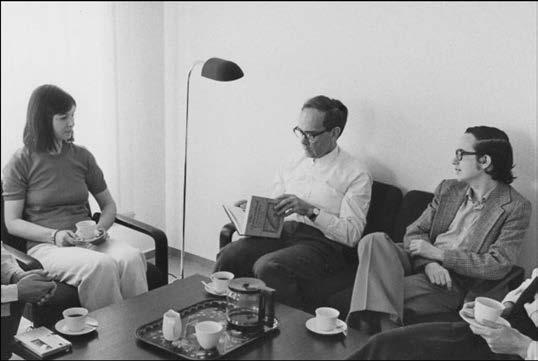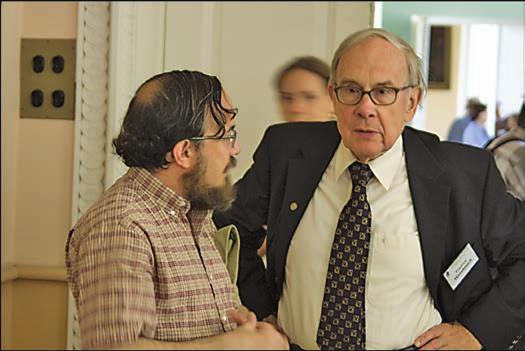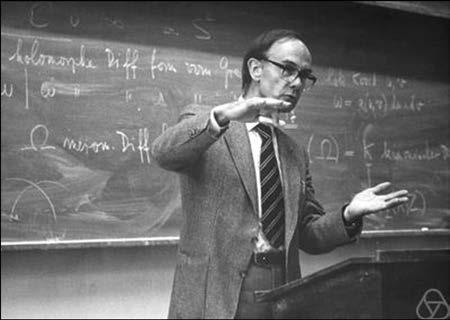by Don Zagier
Entering Fritz’s orbit
That first meeting lasted several hours (in the evening Hirzebruch had to go home, but Brieskorn invited me to a Chinese restaurant to continue the discussion) and resulted in new research projects for me and invitations to come to Bonn a month later for my first Arbeitstagung (also memorable!) and again in the fall as Hirzebruch’s doctoral student. (I remained immatriculated in Oxford, and Hirzebruch received a salary of £5 a year for his work.) As my advisor, he met me frequently, listened to my reports with great attention, and made such minimalistic comments that I always felt the new ideas that emerged were my own, although I did sometimes wonder why everything was working out so much better than it ever had before.

My actual thesis was on a somewhat different subject from the cotangent sums that had provided the initial contact with Hirzebruch, but during the two years that I spent in Bonn as his student and Studentische Hilfskraft, we also had many more discussions about those things, and he gave a course on the subject which turned into our joint book [3] on relations between index theorems and elementary number theory. One of the topics treated in that book, the calculation of invariants of torus bundles over the circle, was to lead him later to his beautiful discoveries, discussed below, on the geometry of Hilbert modular surfaces. Some of this work and of Hirzebruch’s own work in this area is beautifully told in his article [1], whose introduction ends with the words
In the second half of this lecture we shall point out some rather elementary connections to number theory obtained by studying the equivariant signature theorem for four-dimensional manifolds. Perhaps these connections still belong to recreational mathematics because no deeper explanation, for example of the occurrence of Dedekind sums both in the theory of modular forms and in the study of four-dimensional manifolds, is known. As a theme (familiar to most topologists) under the general title “Prospects of mathematics” we propose “More and more number theory in topology.”
As we will see, these last words were to be prophetic in his own case.
I had intended to come to Bonn only for the time needed to complete my thesis, but ended up staying there for my whole life. This development, which I could never have imagined (not only because I knew no German when I came and had no relationship with the country, but also because I am half Jewish and much of my father’s family had perished in the concentration camps), was due exclusively to Hirzebruch’s tremendous personality and to the atmosphere that he created. In the first period after my thesis, I began working more and more intensively with him, first on cotangent sum-related topics and then on Hilbert modular surfaces. Part of this collaboration took place on long train trips to Zürich, where he was giving a course on the latter subject and where I regularly accompanied him because it was the only chance to get him to myself for long periods at a time. In the evenings we often ate together at the elegant Zunfthäuser (guild halls turned into restaurants) of Zürich, gradually becoming better friends and increasing our alcohol consumption from a modest single glass each at the beginning to a full bottle. On one occasion this was increased to one and a half bottles, and Professor Hirzebruch formally proposed the use of “Du” and first names. Henceforth he was always “Fritz” to me, and so he shall remain for the rest of this article. During these years I also got to know his family well, and this too made Bonn become a true home. His daughters, Barbara and Ulrike, also attended my course on elementary number theory. Both had real mathematical talent, but in the end neither one opted for a research career, though Ulrike wrote a master’s thesis on elliptic surfaces with three exceptional fibers that is still quoted regularly today.
Fritz’s work in number theory

Fritz had already done earlier work that is important in the theory of algebraic and arithmetic groups, most notably his fundamental papers with Armand Borel about homogeneous spaces (in particular, the determination of their characteristic classes) and his proportionality principle, which has proved enormously important in the theory of automorphic forms. But starting around 1970 his interest in the relations between topology and number theory became much more intense and led to what one might call a second spring in his mathematical research career. The high point of this was his work on Hilbert modular surfaces, which I now briefly describe.
In the classical theory of modular forms a crucial role is played by the modular curve \[ \mathfrak{H}/\operatorname{SL}(2, \mathbb{Z}) \quad (\mathfrak{H} = \text{complex upper half-plane}) \] and its cousins. The higher-dimensional generalization of this curve is the Hilbert modular variety \( \mathfrak{H}^n /\operatorname{SL}(2, \mathcal{O}_k ) \) associated to a totally real number field \( K \). Here \( \mathcal{O}_K \) is the ring of integers of \( K \) and \( \operatorname{SL}(2, \mathcal{O}_K ) \) is the Hilbert modular group, embedded into \( \operatorname{SL}(2, \mathbb{R})^n \) by the n different real embeddings of \( K \) and hence acting naturally (and discretely) on \( \mathfrak{H}^n \). This variety can be compactified by adding “cusps” to give a projective algebraic variety \( X_K \), but these cusps are highly singular points, with the boundary of a small neighborhood of each cusp being a \( T^n \)-bundle over \( T^{n-1} \) rather than a \( (2n - 1) \)-dimensional sphere. In particular, for \( n = 2 \) these neighborhood boundaries are precisely the torus bundles over a circle that Fritz had already been studying in connection with the equivariant index theorem, and it was this that led him to the study of Hilbert modular surfaces.
He set himself three main goals:
- to describe the geometry of \( X_K \) and calculate its numerical invariants,
- to give for \( n = 2 \) the resolution of the singularities at the cusps, and
- to apply this to the classification of \( X_K \) in the sense of the theory of algebraic surfaces.
He achieved these goals in a series of papers published between 1970 and 1980, partially in collaboration with A. van de Ven and me in the case of part (iii). Each part was mathematics of the highest order. The calculations of the numerical invariants involved deep results from both differential geometry and number theory, including Günter Harder’s extension of the classical Gauss-Bonnet theorem to noncompact manifolds like Hilbert varieties and classical results of Hecke, Siegel, and Curt Meyer about Dedekind zeta functions and class numbers of number fields and their relationship to cotangent sums. The resolution of the singularities in terms of periodic continued fractions was an amazingly beautiful result in itself and also spawned many generalizations, including the theory of toroidal compactifications (work of Mumford, Faltings, and many others) that now plays a central role in the theory of mirror symmetry. The results in part (iii), which culminated in the complete determination of the position of the Hilbert modular surfaces within the Kodaira classification, provided a beautiful collection of algebraic surfaces having particularly interesting properties because of the interplay between their transcendental aspects (description as quotients of \( \mathfrak{H}^2 \)) and their algebraic aspects (description as projective varieties). This interplay leads to many insights that are not available for varieties possessing “merely” an algebraic description. All aspects of the theory are described in the masterful exposition [2].

Fritz’s investigation of the geometry of the Hilbert modular surfaces led him to an intensive study of the modular curves \( T_N (N \in \mathbb{N}) \) that are naturally embedded in these surfaces. This led to a joint paper with me [4] showing that the generating function \( \sum_N[T_n]q^N \) of the classes of these curves in the second homology group of the surface is itself a modular form in one variable, a result that in turn has given rise to many later applications and generalizations (work of Kudla–Millson and many others). There is another amusing anecdote connected with this. Serre, who had studied Fritz’s work on the topological invariants of Hilbert modular surfaces, wrote him a letter pointing out a coincidence between the numbers occurring here and the formulas for the dimensions of certain spaces of modular forms. His letter and Fritz’s giving the explanation in terms of our modularity result crossed in the mail, a nice example of a question being answered before it is received. I should perhaps also mention that this collaboration was one of the most exciting mathematical events of my own life and, I think, meant a lot to Fritz too. On the day when we sent off the final manuscript, we celebrated with a dinner together with our families in a fancy restaurant at which Barbara famously reacted to the bill by computing how many portions of French fries she could buy with the same money.
In later years Fritz worked on many other topics at the interface between number theory and topology that for lack of space I will not describe in detail. A prime example arose in the late 1980s when Ochanine and Witten introduced elliptic genera, which attach modular forms to manifolds. Not surprisingly, Fritz was very interested in this development and wrote some beautiful papers and a book [7] (joint with his students Th. Berger and R. Jung) on this topic. Other topics included the study of Fuchsian differential equations (alone and in collaboration with Paula Cohen) alluded to above and his really beautiful work applying the Miyaoka–Yau inequality and other deep results about characteristic classes of surfaces to classical questions going back to Sylvester (1893) about configurations of points and lines in the plane [5].